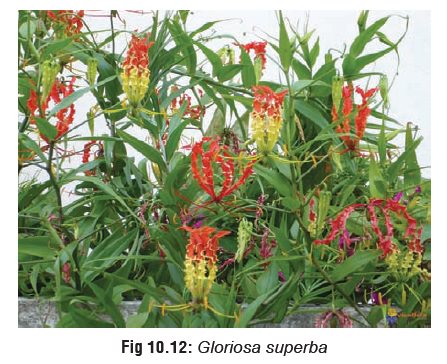Chapter: Modern Medical Toxicology: Organic Poisons (Toxins): Irritant Plants
Glory Lily(Gloriosa superba) - Gastric Irritant Plants

Glory Lily
Botanical Name
Gloriosa superba
Other Common Names
Climbing
lily; Superb lily.
Physical Appearance
This plant belonging to family Liliaceae is a large, herba- ceous,
climbing annual.
■■ It is a slender vine
with a thick tuberous root, resembling a sweet potato.
■■ Leaves
terminate in tendril-like, long, curling tips.
■■ Flowers are large,
solitary, yellow or red, crinkled, and long-stalked (Fig 10.12). They appear to be “upside-down”, with the stamens and
pistils pointing downward.

Uses
·
The juice from the leaves is used as
a pediculoside (to kill head lice).
·
The root is used to treat various
ailments in folk medicine.
Toxic Part
Leaves,
root.
Toxic Principles
Root
contains colchicine and gloriosine. The tubers contain an estimated 6 mg/10 gm
of tuber of colchicine along with gloriosine, which is a related alkaloid.
Clinical Features
·
Acute poisoning with the root
results in severe vomiting, diarrhoea, tachycardia, chest and abdominal pain.
·
More severe effects such as
hypotension, bradycardia, seizures, bone marrow suppression, coagulopathy, ECG
changes, respiratory failure and death have been reported less commonly.
·
Acute colchicine overdose results in
severe toxicity which may be delayed 2 to 12 hours postingestion. Toxic effects
occur in three phases.
·
Early Phase (2 to 24 hours): Severe GI
symptoms(nausea, vomiting, abdominal pain, haemorrhagic gastroenteritis) with
resulting electrolyte abnormalities, volume depletion, and hypotension. Ingestion
often causes numbness of the lips, tongue and throat.
·
Second Phase (24 to 72 hours): Multisystem
failure,with fever and neurological (confusion, coma, ascending peripheral
neuropathy), pulmonary, renal, hepatic, haema-tological, and cardiovascular
toxicity. Seizures have been reported in children. Death may occur from
respiratory failure, cardiovascular collapse, or sudden asystole. Sepsis is a
common cause of death at 3 to 7 days.
·
Third Phase (7 to 10 days): Phase of recovery,
and ischaracterised by a rebound leukocytosis and reversible alopecia. Fever
may persist for several weeks.
Usual Fatal Dose
The
estimated fatal dose of pure colchicine is 7 to 60 mg. The colchicine content
of tubers of Gloriosa superba is
approxi-mately 0.3%. A potentially lethal amount would therefore be contained
in 2.5 to 5 grams of tubers.
Diagnosis
·
High-performance liquid
chromatography-mass spectrom- etry has been described for the identification
and quantifica- tion of colchicine in human serum following a toxic plant
·
Radioimmunoassay and enzyme
immunoassays have also been developed
for colchicine.
Treatment
·
Following a substantial ingestion,
the patient should be period, which may last up to 12 hours.
·
Decontamination:
Activated charcoal therapy may be effective. Colchicine is
believed to undergo enterohepatic recirculation. Multiple dose activated
charcoal may inter- rupt enterohepatic recirculation, though there is no
clinical evidence that this decreases toxicity or improves outcome.
·
Symptomatic
and supportive measures:
o Fluid
and electrolyte status, especially potassium levels, should be followed
closely, with administration of appropriate IV fluids.
o A
complete blood count should be done daily, moni- toring for bone marrow
depression. Patients suffering from bone marrow depression should be isolated
to protect the patient from infection.
o Analgesics
or opiates (with an anticholinergic drug if necessary) may be used to control
severe abdominal pain.
o Ascending
paralysis with respiratory involvement requires aggressive supportive care
including mechan- ical ventilation.
Forensic Issues
·
Accidental poisoning may occur when
the tuber of Gloriosasuperba is
mistaken for sweet potato.
·
Suicidal ingestions are not uncommon
wherever the plant grows well.
Related Topics